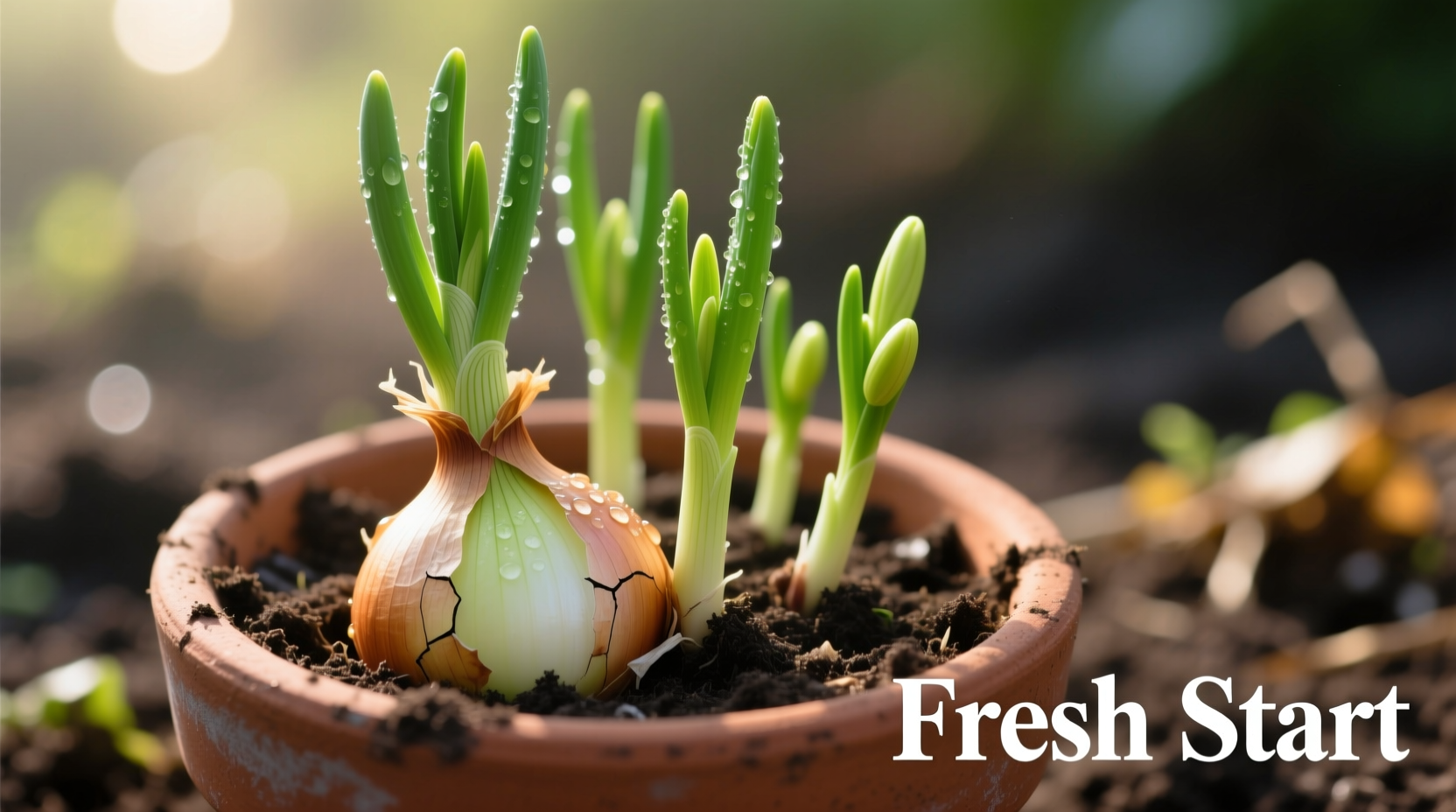Discovering a sprouted onion in your pantry doesn't mean it's time for compost. That green shoot emerging from your forgotten bulb represents a perfect opportunity to grow your own fresh onions with minimal effort. Many home gardeners don't realize that sprouted onions from the grocery store can be revived through proper planting techniques, creating a continuous harvest of scallions or even full-sized bulbs.
Why Sprouted Onions Make Excellent Garden Starts
When onions begin sprouting, they're activating their natural growth cycle. The green shoots you see are actually the plant's first leaves, ready to photosynthesize and grow. Unlike starting from seeds, sprouted onions give you a significant head start in the growing process. According to the University of Minnesota Extension, onions grown from sprouted bulbs typically establish faster than seed-grown plants because they've already broken dormancy.
| Planting Method | Time to First Harvest | Bulb Size Potential | Success Rate |
|---|---|---|---|
| Sprouted grocery store onion | 7-10 days (greens) | Medium (varies by variety) | 75-85% |
| Onion sets | 21-30 days (greens) | Large | 90%+ |
| Seeds | 45-60 days (greens) | Varies | 60-70% |
Preparing Your Sprouted Onion for Planting Success
Not all sprouted onions are equally suitable for planting. Choose bulbs that show these characteristics:
- Firm texture without soft spots or mold
- Multiple healthy green shoots (at least 2-3 inches tall)
- No strong odor indicating decomposition
- Intact root plate at the base
Before planting, separate the green shoots from the bulb if they've grown significantly. The University of California Agriculture and Natural Resources recommends cutting the green portion to about 4 inches tall to reduce moisture loss while the plant establishes roots. This simple step dramatically increases success rates for growing onions from sprouted grocery store bulbs.

Step-by-Step Planting Process
Follow these steps for optimal results when planting your sprouted onion:
- Prepare your container or garden bed: Use well-draining soil with pH between 6.0-7.5. Mix in compost for nutrients.
- Position the onion: Place the bulb with root plate facing down, just below soil surface (top quarter exposed).
- Water thoroughly: Moisten soil completely but avoid waterlogging.
- Provide proper light: Place in location with 6-8 hours of direct sunlight daily.
- Maintain consistent moisture: Water when top inch of soil feels dry.
Growth Timeline: What to Expect Week by Week
Understanding the growth stages helps manage expectations when planting sprouted onions:
- Days 1-7: Roots establish; minimal visible growth above soil
- Days 7-14: Green shoots emerge and grow rapidly (1-2 inches daily)
- Weeks 3-6: Bulb begins forming underground; continue harvesting greens
- Weeks 7-12: Bulb development accelerates with proper care
- Weeks 13-16: Mature bulbs ready for harvest (when tops fall over)
Care Tips for Maximum Yield
While growing onions from sprouted bulbs requires minimal maintenance, these professional techniques will boost your harvest:
- Fertilize every 3-4 weeks with balanced 10-10-10 fertilizer
- Thin plants to 4-6 inches apart for larger bulbs
- Stop watering 1-2 weeks before harvest to improve storage quality
- Rotate crops annually to prevent soil-borne diseases
Remember that grocery store onions are often treated to prevent sprouting, which can affect growth potential. The Royal Horticultural Society notes that organic onions typically perform better when planted compared to conventionally treated bulbs, though both can succeed with proper care.
Harvesting Your Home-Grown Onions
You can enjoy multiple harvests from a single planted sprouted onion:
- Green onions: Snip outer leaves when 6-8 inches tall, leaving inner shoots to continue growing
- Scallions: Harvest when stems reach pencil thickness
- Full bulbs: Wait until tops yellow and fall over naturally
When harvesting mature bulbs, carefully dig around the onion to avoid damage. Cure bulbs in a warm, dry, well-ventilated area for 2-3 weeks before storage. Properly cured onions can store for 2-3 months in cool, dry conditions.
Common Mistakes to Avoid
Even experienced gardeners make these errors when planting sprouted onions:
- Planting too deep (bulb should be partially exposed)
- Overwatering (leads to rot rather than growth)
- Using poor quality soil (onions need well-draining medium)
- Expecting identical bulbs to the original (varies by variety)
- Harvesting too early (bulbs need full maturation for best storage)
Context matters significantly when planting sprouted onions. Success rates decrease dramatically in heavy clay soils without amendment, during extreme heat waves, or when using bulbs that have been refrigerated for extended periods. The USDA notes that onions grow best in temperate climates with consistent moisture, though container gardening makes this project possible almost anywhere.
Transform Food Waste Into Fresh Produce
Planting that sprouted onion you found in your pantry represents one of the simplest food recycling projects you can undertake. Within days, you'll have fresh green onions for salads, soups, and garnishes, all while reducing food waste. This beginner-friendly gardening project works equally well in containers on balconies or in traditional garden beds, making it accessible to virtually all home growers regardless of space limitations.











 浙公网安备
33010002000092号
浙公网安备
33010002000092号 浙B2-20120091-4
浙B2-20120091-4